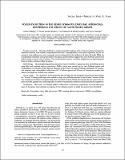Por favor, use este identificador para citar o enlazar a este item:
http://hdl.handle.net/10261/331801COMPARTIR / EXPORTAR:
 SHARE SHARE
 CORE
BASE CORE
BASE
|
|
| Visualizar otros formatos: MARC | Dublin Core | RDF | ORE | MODS | METS | DIDL | DATACITE | |

| Título: | Pollen evolution in the genus echinops (Cardueae, asteraceae): Deciphering the origin of giant pollen grains |
Autor: | Hidalgo, Oriane CSIC ORCID; Sánchez-Jiménez, Ismael CSIC; Palazzesi, Luis; Loeuille, Benoît; Garnatje, Teresa CSIC ORCID | Palabras clave: | Compositae Exine Light microscopy (LM) Scanning electron microscopy (SEM) Syncephalium |
Fecha de publicación: | 1-may-2023 | Editor: | University of Chicago Press | Citación: | International Journal of Plant Sciences 184 (5): 366- 377 (2023) | Resumen: | Premise of research. The genus Echinops is unique among the Cardueae tribe of Asteraceae for presenting two distinctive features, both related to reproductive structures: a syncephalium (=secondary capitulum) and an impressively large pollen grain with a triangular section and probably the thickest of all plant cell walls. While the syncephalium constitutes a synapomorphy for the genus, recent evidence suggests that some Echinops species have pollen similar to that of other Cardueae. This study therefore seeks to contribute insights into the spatiotemporal frame of pollen evolution within the genus. Methodology. Micromorphological characterization was provided for 35 specimens from 28 Echinops species using light and scanning electron microscopy. Pollen counts were carried out for two Echinops species and Cardopatium corymbosum. Pollen data are discussed in the context of a dated Echinops phylogeny. For comparison purposes, new and published pollen data of 622 Cardueae species and 303 taxa of Vernonieae, another tribe where syncephaly has evolved, were collated. Pivotal results. The "Perennial" Echinops pollen type of huge size and triangular section likely derived from the "Annual" Echinops pollen type, more similar in shape, size, and exine structure to that of other Cardueae. Pollen type transition took place in the genus long after syncephaly evolved. Pollen size increase did not occur at the expense of pollen quantity and could respond to warmer environmental conditions and increased male competition. Conclusions. This study of Echinops pollen evidenced the evolutionary exploration of novel phenotypic space in the genus, most certainly in response to the climatic context in which the species have diversified. | Versión del editor: | https://doi.org/10.1086/724497 | URI: | http://hdl.handle.net/10261/331801 | DOI: | https://doi.org/10.1086/724497 | Identificadores: | doi: https://doi.org/10.1086/724497 issn: 1058-5893 |
| Aparece en las colecciones: | (IBB) Artículos |
Ficheros en este ítem:
| Fichero | Descripción | Tamaño | Formato | |
|---|---|---|---|---|
| Pollen evolution.pdf | 683,39 kB | Adobe PDF |  Visualizar/Abrir |
CORE Recommender
Page view(s)
29
checked on 01-may-2024
Download(s)
72
checked on 01-may-2024
Google ScholarTM
Check
Altmetric
Altmetric
Este item está licenciado bajo una Licencia Creative Commons

